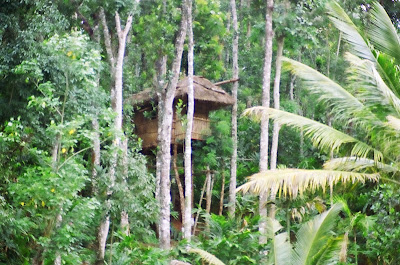Sleeping in a tree house in pitch darkness: Having been brought up in a village, I am more used to dark nights. So darkness was not totally new to me. But this was too real. you could feel it. you could even touch it if you wanted. It was so thick and engulfed me that i wondered if it would prevent me from moving around- a kind of very viscous fluid. If some person or animal or an object was a feet away, you couldn't see them.
I wanted to describe the darkness as day being painted with a huge container of pitch black paint. Then stopped when i realized that that is what nature had actually done. :) Back in the city, where night is turned into day with all the lights on and where you couldn't even see the stars, i understand that no amount of explanation will do to a city dweller.You have to just experience it.
We had to walk to the tree house from our home stay. We had a torch (very powerful, something similar to surefire) and the tree house also had electric lights that were switched on. There were 3 CFL bulbs to be precise, 2 on the front and back of the house and one inside. We were warned to keep the lights on when we slept. When we entered the house (a misnomer as it was a 10x10 feet room), a spider just went out of the other door. It was precisely for this reason, we were asked to keep the lights switched on, i.e. ward off the insects. But the lights also attracted lot of moths and other similar insects. So we had to switch it off. When you are bone tired with a day’s activity, all you need is a place to sleep. Nothing else really matters and i slept soundly.
This is the tree house.
 |
| Tree House |
 |
| Elephants |
 |
| Lake in Mist |
 |
| Checking the socks |
The leech is a like a miniature trunk of an elephant. The broader sticky side, clings to a (ny) surface and the narrow (pointed) side, searches for a surface to suck blood from. This end of the leech moves like an elephant trunk. And the body of the leech is so elastic that it expands and contracts to 1/4th or 1/5th of its original size. When a leech that is completely expanded in search for a surface, contracts to 1/5th its original size, it looks as if the leech has entered the surface. A leech had clung to my cargo pant close to my left hand side pocket. When I saw the leech contracting, I thought that it has entered my pant. This was the reason for my fear.
The guide told me that leeches can’t pierce a surface and enter it and that we were safe unless there is an opening in our trouser or socks. After this my fear subsided. Even then, we stopped at least four or five times to apply salt on our shoes and check our dresses. It was then that I realized that we should not be wearing sneakers like NIKE or ADDIDAS. These are no good in this kind of terrain and we should have been wearing proper trekking boots. I was fortunate that the leeches didn’t enter my shoes, but the people who came with me were not that fortunate.
 |
| Big Tree |
Here is another elephant that we shot. This was taken in the evening and the guide told us that this is an old elephant. The elephant didn't care about our presence and was happily munching away. May be she had enough of visitors for the day and didn't want to see one more.
When i reminisced about the trip later, i can confidently say i some what understand and completely appreciate the pain people take to shoot photos and documentaries in tropical forests, the kind shown on National Geographic or Animal Planet. I will definitely do the trek again, if I get a chance.
We also visited Eravikulam national park in Munnar and took some shots of the endangered Niligiri Tahr (Mountain goat). Transport is not allowed beyond a point and we had to walk to the top. The funny part is that on the way to the top, i was searching for the Tahr to get some photos and with great difficulty managed to get a few and the mist also made it difficult . Here is a silhoutte.
 |
| Tahr - A silhoutte |
 |
| Camera friendly Tahr :) |



